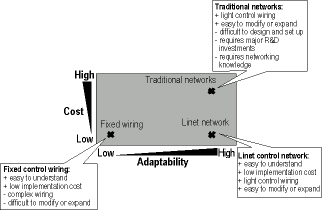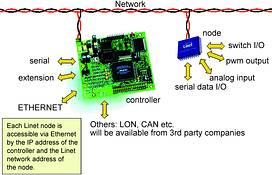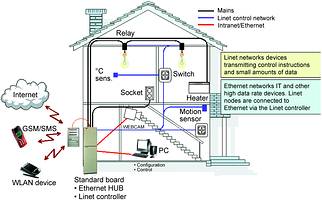
Linet is a light and easy local operational network system. Also reliable and low cost, Linet allows networking between electrical devices and is used to control simple devices - relays, heaters, sensors, etc - without the need to develop application specific software or investments in development tools or learning. For OEM producers, Linet offers more features, less costs, and faster time to market.
To build a traditional distributed control system, one either has to use hardwired control wiring, or the high-end control network developed to communicate between microprocessor systems. The former is laborious to install and static, while the latter leads to the use of expensive design tools and complex solutions in simple applications.
Linet is positioned between these two approaches. It is a completely new system, designed to fulfil the need for a simple network between simple devices. It is easy to understand and operate, just as fixed control wiring, while offering the dynamics, scalability and other advantages of modern network systems.
A Linet network consists of a Linet controller and Linet network nodes connected by twisted-pair cabling. The nodes link simple devices into the network. The readymade functions, such as On/Off, are used to transmit the functional signal from a selected device via the Linet nodes and network to another device of one's choice. This is the Linet way to implement distributed control systems with minimal hard-wiring and no programming. Other functions, and even data transfer, are performed similarly, using the Linet nodes along with the desired devices.

The Linet node
* Low cost single chip network node.
* Ultra low power consumption.
* Minimum external components.
* Polarity free 2-wire bus connection.
* On/Off input and output function.
* PWM/Phase angle output function.
* Full-duplex serial data I/O function.
* Internal A/D converter.
The Linet node is an extremely small and simple-to-use network adapter for the Linet local operational network. The node provides the network interface, the internal power supply, and the ready made I/O-functions on a single silicon chip. The node is available in two versions: an IC or a hybrid. The IC is an SMT packaged node, requiring only a few external low-cost components to operate, and is intended for price and size sensitive OEM applications. The hybrid is a ready-to-use plug-and-play network card for embedded systems, ideal for small production volumes or product development.
All nodes include all Linet functions. The function to be activated on each node is selected while the network is configured. Many systems are completed by using just the basic I/O functions, so they are made up and run without writing a single line of software. Applications requiring distributed intelligence can be developed by placing any microcontroller next to the node, and then using the Linet system to transmit raw serial data between the microcontrollers, or between the microcontroller and a host.
The network cable in the Linet system is single twisted pair cable. Both data and operating power required by the nodes are transmitted in the same, single pair. The cabling is totally topology and polarity free, and no terminating resistors are needed. This provides for maximum flexibility in designing, installing and modifying the network.

The Linet controller
* Supplies power to the nodes in the network.
* Supplies carrier and timeslots to the nodes.
* Offers the services to configure and administer the network.
* Can operate as a user interface.
* Operates standalone, or forms a link to host systems.
The controller is an intelligent power supply for the nodes in the network. It is the logical link between the nodes in the network, or between the nodes and a host. It also provides network configuration services, eliminating the need for any Linet-specific design or configuration tools.
The controller is shipped with software running the Linet system and offering the basic set of network functions. When application-specific extensions are required, they may be added to the controller software, or the controller may form a link to a computer or a host system.

Application example - home automation
Use of automation in controlling electrical home appliances improves security and comfort, and reduces energy consumption. Today, many home automation systems are available as separate products that are hardwired to the building. As separate systems are installed, the total amount of cabling becomes unmanageable. Such a system is difficult, or impossible to modify or expand. Linet is an excellent base to expand the use of low-level building automation into one family house. It offers the functionality that meets the requirements in these applications where its competitors are far too expensive and difficult to adopt.
For more information contact Analog Data Products SA, 011 259 9400.
© Technews Publishing (Pty) Ltd | All Rights Reserved